Abstract
SiC particles-reinforced Al matrix composites (SiCp/AMCs) have been widely used in the aerospace structural components. In this work, 20 vol% SiCp/2A14 joint was fabricated by laser welding technology. The effects of different laser power/welding velocity on the 20 vol% SiCp/2A14 joint forming, microstructure evolution and mechanical properties were studied in detail. The results showed that, under the same heat input, the high power/high welding velocity was beneficial to reduce the porosity of SiCp/2A14 joint and inhibited the formation of brittle phase of Al4C3. At 8 kW-133 mm/s welding parameters, the maximum tensile strength of the SiCp/2A14 joint reached 199 MPa, which is ~64% higher than that of the SiCp/2A14 joint prepared at 4 kW-66 mm/s welding parameters. By analyzing the fracture morphology and SEM image of SiCp/2A14 joint section, it is was found that the porosity of weld and Al4C3 brittle phase were the important factors limiting the strength of SiCp/2A14 joint. This work provides a reference for the process window design of laser welding SiCp/2A14 composites.
1. Introduction
Today, energy conservation and emission reduction is the goal of unremitting efforts in the world, which is one of the requirements in the field of materials is to achieve the preparation and processing of light and high strength alloys [1,2]. As an advanced material integrating structure and function, SiC particles-reinforced Al (SiCp/Al) can be widely used in the field of aerospace structural components [3,4]. The joining of alloys is an indispensable technology in the current manufacturing process, and the study of the welding behavior of new SiCp/Al alloy is the key to further application in the field of aerospace [5,6]. Examilioti et al. systematically designed a series of welding process parameters to fully understand the welding characteristics of AA2198. Its design process parameters are laser power increased from 5 kW to 8 kW. They reported that the combination of high power and high welding speed is conducive to the formation of type I welds, thus improving the joint strength [7].
It is well known that the phase interface of metal matrix composites plays an important role in structural and functional properties [8,9,10]. Unfortunately, SiCp/Al is recognized as one of the most challenging fusion welding materials due to deterioration of SiCp/Al joint properties caused by interfacial reaction between SiC particles and Al matrix (4Al + 3SiC → 3Si + Al4C3) [11]. In the field of fusion welding, the most effective strategy was to add alloy foil to suppress the volume fraction of brittle phase of Al4C3, so as to improve the strength of SiCp/Al joint [12,13,14]. However, the strategy of adding alloy foil had two major shortcomings. One is that the alloy foil usually reacted with aluminum to form large brittle phases such as Al3Ti and Al3Zr, which reduced the toughness of the SiCp/Al joint [12,14]. Second, the foil layer was difficult to evenly distribute in the fusion zone. The unmelted alloy foil layer was concentrated in the center of the fusion zone [12]. With the development of laser technology, the laser power, spot size and spot energy distribution have been greatly studied and developed, which provided a new possibility for laser welding SiCp/Al composites [15,16]. Hence, it will provide new understanding to seek the process strategy of laser welding SiCp/Al composites, which is related to whether the reaction degree of SiC can be reduced by adjusting the welding process parameters.
This work cleverly controls the reaction degree of SiC by controlling the residence time of molten pool. Under the same heat input, the process parameters of different laser welding power/welding velocity were designed. This work carefully characterized the microstructure of the 20 vol% SiCp/Al joint, and the morphology evolution mechanism of SiC during high laser power/welding velocity was revealed in detail. This work provides a new insight into the inherent relationship between the microstructure and mechanical properties of the 20 vol%SiCp/Al joint.
2. Materials and Methods
T6 condition-SiCp/2A14Al composites with volume fraction of 20 vol% SiC particles was selected as the base material (Figure 1). The 20 vol% SiCp/Al was purchased from Shenzhen Superior Technology New Material Co., LTD. Detailed information about SiCp/Al composite materials are as follows: Cu 3.9–4.8, Mn 0.4–1.0, Si 0.6–1.2, Mg 0.4–0.8, Zn ≤ 0.3, Ti ≤ 0.15, Ni ≤ 0.1, Al bal (wt. %). The size of SiCp/2A14 Al base material was 100 mm × 30 mm × 4 mm.
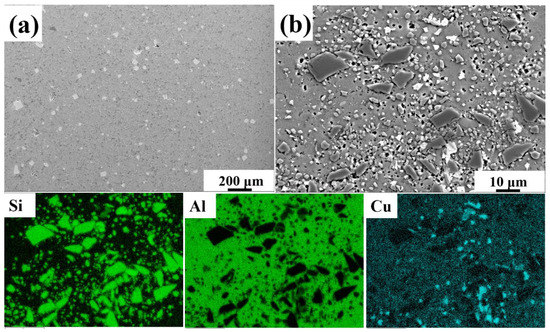
Figure 1.
SEM images of 20 vol%SiC/2A14 base material and corresponding surface elements distribution mapping. (a) SEM image of base material with low magnification; (b) SEM image of characteristic region of base material.
The laser beam welding system was composed by an IPG YLS-30000 fiber laser system with a Kuka IRB-6400 robot. The size of the laser spot is 500 μm. The 100% Ar was used as shielding gas during the welding process. The processing parameters for laser butt welding are shown in Table 1.

Table 1.
Laser welding parameters.
A sample with a size of 10 mm × 5 mm × 4 mm was cut via wire electric discharge machine. The metallographic samples were prepared by automatic grinding and polishing machine (EcoMet 250, BUEHLER, USA) according to the standard sample preparation process. SEM was performed using a Gemini SEM300 scanning electron microscope (SEM) manufactured by Carl Zeiss (Oberkochen, Germany).
Microhardness of SiCp/2A14Al joints were measured by HVS-1000A Vickers hardness machine (Laizhou, China) with a test load of 300 g and a dwell period of 15 s. Tensile specimens with the gauge length of 15 mm, gauge width of 6 mm and thickness of 4 mm were machined parallel to the transverse direction. Uniaxial tensile tests for each specimen were performed using a high temperature endurance testing machine (Autograp AG-IC 100 kN, Shimadzu, Japan) with a constant strain rate of 2 mm/min at ambient temperature. Each group of tensile experiment was repeated two times.
3. Results
3.1. Microstructure Characterization
Figure 2 shows the SEM images of the welded joint cross section. It can be seen that even under the same nominal heat input (60 J/mm), the welded joint cross-section porosity shows distinct differences. Sample Y1 showed a large number of pores, and the pores were densely distributed in the upper and lower areas of the weld. When the laser welding power was 8000 W-133 mm/s, the number of pores in sample Y2 decreased obviously. In the metallurgical reaction process of welding molten pool, the temperature and cooling rate of the molten pool control the growth morphology of microstructure and the reaction degree of SiC particles (the preferred growth factor of intrinsic crystal structure of the phase is not considered here temporarily). Due to the presence of SiC in aluminum matrix, the viscosity of molten pool increased with the increase of SiC content in the welding process, which increases the difficulty of gas escape in the welding process [17,18]. When the welding power and welding velocity were changed at the same heat input, the porosity of the joint cross section showed great difference, as shown in Figure 2. The melt viscosity of SiCp/2A14 metal matrix composites was also affected by the volume fraction of SiC particles. A large number of solid particles in the molten pool obstruct the flow in the welding process. During laser welding, the plasma pressure makes the fluid in the molten pool move violently, which has an important influence on the redistribution of the enhanced phase in the molten pool. Therefore, the increase of laser power may increase the degree of molten pool fluid reaction and form a penetrating deep fusion welding mode. At the same time, stomatal escape channels are more favorable, resulting in lower stomatal rate.
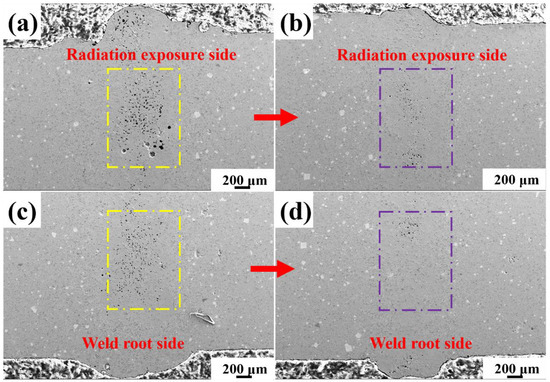
Figure 2.
SEM image of 20 vol%SiC/2A14 joint cross section. (a,c) Representative sample Y1; (b,d) Representative sample Y2.
Figure 3 shows the typical microstructure images of the SiC/2A14 joint, which could be roughly divided into α-Al matrix, Al-Cu phase and long rod Al4C3 brittle phase. Furthermore, it can be seen from the distribution diagram of element in Figure 3c that some Si elements were distributed in disorder and the other in eutectic phase. The carbon atoms provided by the dissolution of SiC reacted with α-Al first, and Si atoms were distributed in the form of solid solution and compound formation such as Mg2Si.
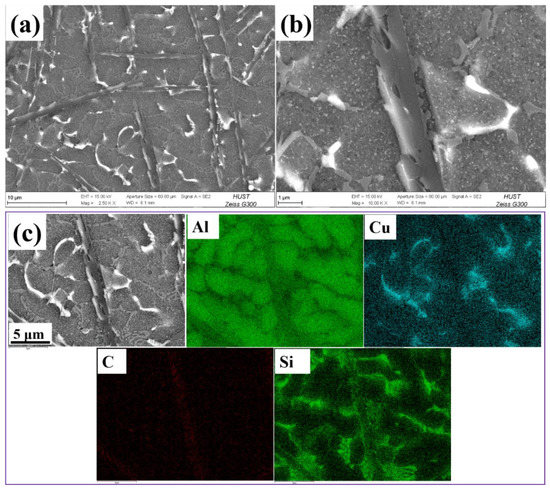
Figure 3.
SEM image and elements mapping of 20 vol%SiC/2A14 joint cross section. (a–c) Representative sample Y1.
For laser welding of particle-reinforced aluminum matrix composites, the degree of reaction between SiC particles and aluminum matrix in welding molten pool and the reaction products are important factors to construct the microstructure of fusion zone. In order to better reflect the reaction behavior of SiC particles in the molten pool, Figure 4 shows the SEM morphology of SiC particles in the fusion zone. As can be seen from Figure 4, the surface of SiC particles was decomposed to varying degrees. Long rods of Al4C3 are distributed around SiC. However, it is worth noting that the formation path of acicular Al4C3 is complex, which is mainly related to the thermal environment of the welding molten pool. For the design strategy of this work, the combination of two sets of process parameters with different laser power/welding velocity created a molten pool with two different thermal conditions, which determined the reaction time of SiC particles in the molten pool. In the laser welding process, the area formed by the keyhole had a relatively high temperature field. The SiC particles subjected to the keyhole also have the strongest dissolution and even decomposition effect. In the molten pool formed near the keyhole, SiC was retained in the molten pool due to its high melting point (2730 °C) without direct laser beam under ideal assumption, but the dissolution reaction of SiC will continue. That is to say, the energy of the keyhole (laser power/laser spot size) determines the melting behavior of part of the SiC, and the retention time of the molten pool per unit length determines the SiC dissolution behavior.
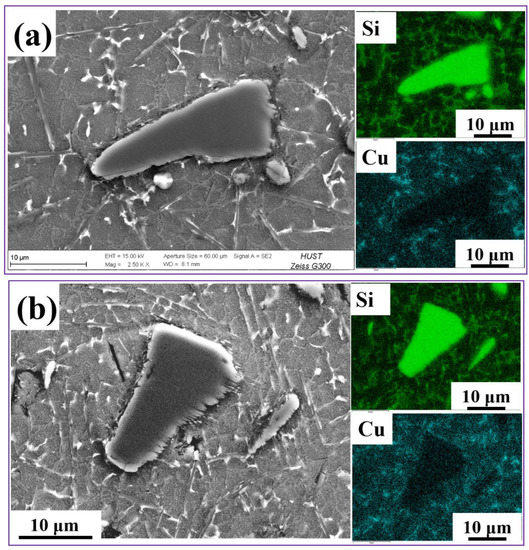
Figure 4.
SEM image of SiC in the fusion zone. (a) Representative sample Y1; (b) Representative sample Y2.
Figure 5 shows the characteristic morphology and dissolution behavior of SiC in the fusion zone of Y2 joint. From the SEM morphology, it can be clearly seen that the dissolution behavior of SiC particles occurs at the edge of SiC particles. The dissolution behavior was synchronized with the precipitation behavior. It can be explained that the SiC particles begin to dissolve at the edge of the particle due to the influence of high temperature in the molten pool, and the dissolved products Si and C react rapidly with liquid Al. In addition, a large number of carbon atoms around SiC particles were rapidly consumed. However, Si atoms cannot be consumed well, leading to local Si enrichment, which slows down the dissolution and precipitation behavior to a certain extent [19,20]. Si element is the product of the reaction; the addition of Si element will reduce the reaction of the interface reaction rate, effectively inhibiting Al4C3 production, but also significantly improve the interface wettability. Ti doping can significantly improve the separation of interfaces with different configurations. However, Mg and Cu doping can terminate the interface binding ability of Al/Si, but C and SiC interface separation effectivity is reduced, so the enhancement effect of interface bonding is limited [21,22,23,24].
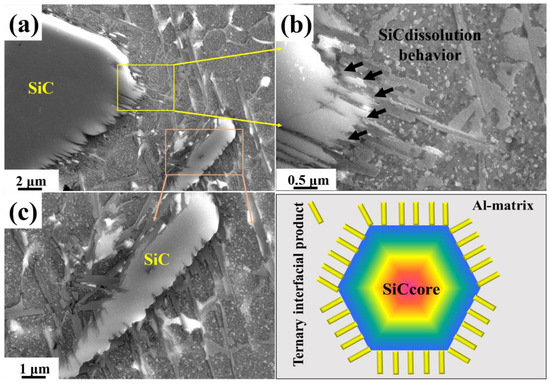
Figure 5.
Characteristic SEM image of SiC and schematic diagram of its dissolution behavior in the sample Y2. (a) Microstructure near dissolved SiC in a weld; (b,c) SEM detail image of feature region in (a); (c) Schematic diagram of SiC dissolution.
For the dissolution and precipitation behavior of particles, the interface products at the particle interface was an interesting discussion. For the SiC particles in the molten pool, the unmelted SiC tends to form Al-Si-C ternary reaction products in the form of dissolution and precipitation. Although Al4C3 is prone to hydrolysis reactions that reduce the mechanical properties of the SiCp/Al joint, some studies have shown that the nano-scale Al4C3 was conducive to load transfer and enhanced the mechanical properties of the alloy. In the laser welding process, SiCp/Al particles dissolved in the molten pool with the melting of aluminum matrix. Therefore, the microstructure of the weld was essentially the aluminum matrix reinforced by ex situ SiC particles. Compared with the in situ formation particles-reinforced aluminum matrix, the cracks usually initiate and expand rapidly in the stress concentration region on the particle surface [25,26]. Therefore, the bonding strength of the interface between the particles and matrix determines the mechanical properties of the composites [27]. The interfacial bonding strength between SiC particles and aluminum matrix can be improved by regulating in situ Al-Si-C ternary products around SiC particles.
3.2. Microhardness and Tensile Strength
Figure 6 shows the microhardness curves of the cross-section of the joint. The distance between adjacent microhardness points was 0.2 mm. As can be seen from Figure 6, due to the secondary rearrangement of SiC, porosity and Al4C3, the joint microhardness presents a trend of uneven change.
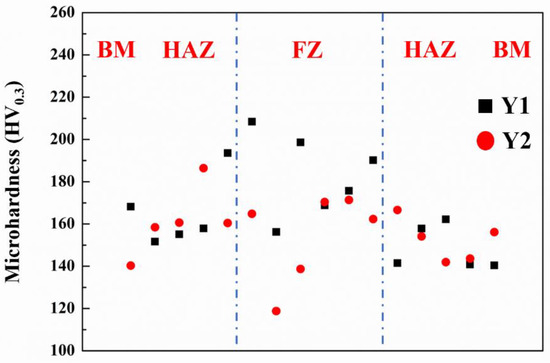
Figure 6.
Microhardness curves of two samples.
Figure 7 shows the tensile strength curve of the welded joint. The combination of ‘laser power-welding velocity’ strongly affected the tensile strength of the welded joints. For the laser welding process parameters of 4 kW-66 mm/s, the tensile strength of the welded joint Y1 was 121 MPa, while the tensile strength of the welded joint Y2 prepared by the welding process parameters of 8 kW-133 mm/s was 199 MPa. In general, the nominal tensile strength of the joint depends on two factors: weld formation and microstructure. Among them, welding forming includes whether the joint has defects such as edge bite and welding porosity, as shown in Figure 2. The microstructure of the joint is the key factor to determine the mechanical properties of the joint. For the 20%SiC/2A14 joint, the microstructure region could be roughly divided into fusion zone, heat affected zone and base zone. A needle-like brittle Al4C3 phase appeared in the fusion zone of the weld. The SiC enrichment appeared between the heat-affected zone and the fusion zone, both of which did not occur in the base material, as shown in Figure 2.
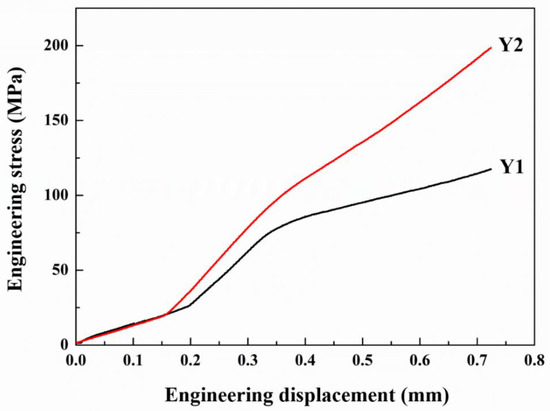
Figure 7.
Engineering stress-engineering displacement curves of two samples.
In order to better reflect the internal relationship between microstructure and mechanical properties, the tensile fracture morphology of the joint is shown in Figure 8. Without exception, the SiC reaction products observed in the cross section of the weld are needle-like/long rod shape, while a large number of step-like phases are observed in the fracture. It can be reasonably inferred that the morphology and distribution orientation of Al4C3 were not formed randomly. Al4C3 were determined by external thermal environment factors such as molten pool temperature gradient and intrinsic crystal growth structure factors of Al4C3.
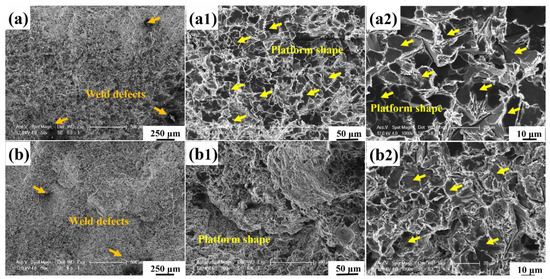
Figure 8.
SEM characteristic images of fracture morphology of two groups of joints. (a–a2) Representative sample Y1; (b–b2) Representative sample Y2.
Surprisingly, the fracture morphology of both joints showed a large number of steps, and the combination of low power/low welding velocity (4 kW-66 mm/s) process parameters showed more fracture steps. Therefore, according to the SEM morphology shown in Figure 2, the real morphology of two-dimensional acicular Al4C3 should be flake and fracture parallel to the flake surface during fracture, which also explains the origin of numerous stepped morphology in the tensile fracture.
4. Discussion
Based on the above results, the welded joint tensile strength was greatly improved under the process strategy of controlling the combination of laser welding parameters, and its internal control factors need to be further understood. These are as follows:
(i) Influence of welding process parameter on tensile strength. For the laser welding SiC particle-reinforced aluminum matrix composites, the welding difficulty not only has serious interface reaction difficulty between SiC particles and Al matrix, but also, the introduction of SiC particles aggravate the formation of porosity in laser welding aluminum alloy. In this study, a large number of pores appeared in the welding of 20 vol% SiC/2A14 composites, mainly distributed at the upper and lower ends of the weld cross-section. Although the number of pores was effectively reduced by optimizing the process parameters, sample Y2 still showed unsatisfactory porosity, as shown in Figure 2.
(ii) Influence of morphology of Al4C3 on tensile strength. In general, the growth of Al4C3 was related to the inter-diffusion of Al and C atoms, and the growth rate (dw/dt) of Al4C3 could be expressed based on Arrhenius’s law Equation (1),
where k, w, Q, R, t, and T are the constant, weight of Al4C3, activation energy, gas constant, holding time, and temperature, respectively [28,29,30,31]. As a result, the growth rate of Al4C3 increases with temperature increasing, and decreases with holding time prolonging [28].
Jiang et al. investigated the nucleation and growth mechanism of aluminum carbide in graphene nanosheet/Al composites. They found that the longitudinal growth interface Al4C3 grew faster along the (003) plane than along the (003) plane, most of which grew into rods [28]. Since the longitudinal growth of Al4C3 was controlled by diffusion, there are C and Al in both Al4C3 and Al matrix, while the lateral growth of Al4C3 was affected by the nucleation rate at the interface [32]. The rhomboid structure (R-3M) of Al4C3 consists of superposed layers of Al2C and Al2C2 [33]. In the Al2C layer, C atoms were tightly packed in the octahedral void of Al atoms, but not tightly packed in the Al2C2 layer. Thus, transverse diffusion of C atoms through the Al2C2 layer was expected, since the Al2C layer would block normal diffusion [34]. Thus, the growth of Al4C3 along the X direction was determined by the diffusion of C atoms in the Al2C2 layer, while the growth along the Y direction was determined by the alternate nucleation of Al2C2 and Al2C layers [28]. The difference in growth rates between the two directions eventually resulted in the rod-like appearance of Al4C3. Based on the above analysis, Al4C3 phase tended to nucleate at the opening edge of SiC due to its high chemical reactivity. Thereafter, the growth of Al4C3 was controlled by its crystal structure characteristics, which determine the growth and morphology of Al4C3 [35].
Figure 9 shows the schematic diagram of two Al4C3 in laser welded SiCp/2A14 composites. Similarly, it can be seen from Figure 5 and Figure 8 that the morphology of Al4C3 can be subdivided into two types. One is complete Al4C3, which has a sheet shape. The other is the non-complete Al4C3 phase around SiC particles. Therefore, it is reasonable to speculate that the growth morphology of Al4C3 was closely related to the temperature field of molten pool. The cooling rate of the molten pool near the keyhole was relatively slow, which was conducive to the full nucleation and growth of Al4C3. In the area near the fusion line, due to the faster cooling rate and lower temperature field, the nucleation and growth behavior of Al4C3 cannot be fully carried out. So, the growth of incomplete Al4C3 was found around the SiC.

Figure 9.
The schematic diagram of two Al4C3 in laser welded 20 vol% SiCp/2A14 composites.
5. Conclusions
In this study, the 20 vol% SiC/2A14 composites were systematically studied for laser welding. Based on the SEM characterizations and fracture behavior analysis, the main conclusions can be summarized as follows:
(1) Under the same heat input 60 J/mm, the process parameters of high power/high welding rate were beneficial to reduce joint porosity. The increase of laser power was beneficial to improve the viscosity of molten pool. The increase of welding rate was beneficial to reduce the dissolution reaction time of SiC, which synergically improved the joint strength.
(2) Compared with the welding parameters of 4000 W-67 mm/s, the tensile strength of the joint prepared with 8000 W-133 mm/s welding parameters can reach ~199 MPa, which is ~64% higher. The brittle phase of Al4C3 formed during laser welding was the key factor restricting the strength of the joint, and its distribution pattern further reduces the strength of the joint.
(3) During laser welding, the plasma pressure makes the fluid in the molten pool move violently, which has an important influence on the redistribution of the enhanced phase in the molten pool. The increase of laser welding power form a penetrating deep fusion welding mode. At the same time, stomatal escape channels are more favorable, resulting in lower stomatal rate.
(4) The morphology of Al4C3 can be subdivided into two types. One is complete Al4C3, which has a sheet shape. The other is the non-complete Al4C3 precipitation around SiC particles. The cooling rate of the molten pool near the keyhole is relatively slow, which is conducive to the full nucleation and growth of Al4C3.
Author Contributions
Conceptualization, F.L. and C.W.; methodology, Y.J.; software, G.M.; data curation, M.Z.; writing—original draft preparation, F.L.; writing—review and editing, C.W.; supervision, C.W. All authors have read and agreed to the published version of the manuscript.
Funding
This research received no external funding.
Conflicts of Interest
The authors declare no conflict of interest.
References
- Martin, J.H.; Yahata, B.D.; Hundley, J.M.; Mayer, J.A.; Schaedler, T.A.; Pollock, T.M. 3D printing of high-strength aluminium alloys. Nature 2017, 549, 365–369. [Google Scholar] [CrossRef] [PubMed]
- Jiang, S.; Wang, H.; Wu, Y.; Liu, X.; Chen, H.; Yao, M.; Gault, B.; Ponge, D.; Raabe, D.; Hirata, A.; et al. Ultrastrong steel via minimal lattice misfit and high-density nanoprecipitation. Nature 2017, 544, 460–464. [Google Scholar]
- Qiao, Q.; Su, Y.; Ouyang, Q.; Zhang, D.; Song, X.; Guo, L. Microstructural characterization and mechanical properties of 120-mm ultra-thick SiCp/Al composite plates joined by double-sided friction stir welding. Met. Mater. Trans. A 2019, 50, 3589–3602. [Google Scholar] [CrossRef]
- Song, J.; Guo, Q.; Ouyang, Q.; Su, Y.; Zhang, J.; Lavernia, E.J.; Schoenung, J.M.; Zhang, D. Influence of interfaces on the mechanical behavior of SiC particulate-reinforced Al-Zn-Mg-Cu composites. Mater. Sci. Eng. A 2015, 644, 79–84. [Google Scholar] [CrossRef]
- Niu, J.; Pan, L.; Wang, M.; Fu, C.; Meng, X. Research on laser welding of aluminum matrix composite SiCw/6061. Vacuum 2006, 80, 1396–1399. [Google Scholar] [CrossRef]
- Qiao, Q.; Su, Y.; Cao, H.; Zhang, D.; Ouyang, Q. Effect of post-weld heat treatment on double-sided friction stir welded joint of 120 mm ultra-thick SiCp/Al composite plates. Mater. Charact. 2020, 169, 110668. [Google Scholar] [CrossRef]
- Examilioti, T.N.; Kashaev, N.; Enz, J.; Klusemann, B.; Alexopoulos, N.D. On the influence of laser beam welding parameters for autogenous AA2198 welded joints. Int. J. Adv. Manuf. Technol. 2020, 110, 2079–2092. [Google Scholar] [CrossRef]
- Yu, Z.; Tan, Z.; Xu, R.; Ji, G.; Fan, G.; Xiong, D.-B.; Guo, Q.; Li, Z.; Zhang, D. Enhanced load transfer by designing mechanical interfacial bonding in carbon nanotube reinforced aluminum composites. Carbon 2019, 146, 155–161. [Google Scholar] [CrossRef]
- Chen, B.; Shen, J.; Ye, X.; Imai, H.; Umeda, J.; Takahashi, M.; Kondoh, K. Solid-state interfacial reaction and load transfer efficiency in carbon nanotubes (CNTs)-reinforced aluminum matrix composites. Carbon 2017, 114, 198–208. [Google Scholar] [CrossRef]
- Zhou, W.; Yamaguchi, T.; Kikuchi, K.; Nomura, N.; Kawasaki, A. Effectively enhanced load transfer by interfacial reactions in multi-walled carbon nanotube reinforced Al matrix composites. Acta Mater. 2017, 125, 369–376. [Google Scholar] [CrossRef]
- Kawai, C. Effect of interfacial reaction on the thermal conductivity of Al-SiC composites with SiC dispersions. J. Am. Ceram. Soc. 2001, 84, 896–898. [Google Scholar] [CrossRef]
- Chunming, W.; Liu, C.; Wang, C.; Xiong, L.; Ouyang, Q. The effect of Zr addition on the laser welding of SiCp/2A14Al composite. J. Mater. Res. Technol. 2021, 15, 5175–5186. [Google Scholar]
- Long, J.; Zhang, L.-J.; Zhang, L.-L.; Wang, X.; Zhang, G.-F.; Zhang, J.-X.; Na, S.-J. Effects of minor Zr addition on the microstructure and mechanical properties of laser welded joint of Al/SiCp metalmatrix composite. J. Manuf. Process. 2020, 49, 373–384. [Google Scholar] [CrossRef]
- Hua, Z.; Wang, C.; Mi, G.; Jiang, P.; Xiong, L. Effects of Ti on the forming, microstructure and mechanical properties of laser welded joints of SiCp/2A14 composites. J. Mater. Res. Technol. 2021, 15, 6272–6286. [Google Scholar] [CrossRef]
- Enz, J.; Riekehr, S.; Ventzke, V.; Huber, N.; Kashaev, N. Fibre laser welding of high-alloyed Al-Zn-Mg-Cu alloys. J. Mater. Process. Technol. 2016, 237, 155–162. [Google Scholar] [CrossRef]
- Huang, Y.; Hua, X.; Shen, C.; Li, F.; Ding, Y.; Mou, G. Metal evaporation flux across Knudsen layer in laser keyhole welding of Al-Mg alloys with pressure balance condition method. Appl. Surf. Sci. 2021, 536, 147838. [Google Scholar] [CrossRef]
- Timofeeva, E.V.; Routbort, J.L.; Singh, D. Particle shape effects on thermophysical properties of alumina nanofluids. J. Appl. Phys. 2009, 106, 014304. [Google Scholar] [CrossRef]
- Heiple, C.; Cr, H. Mechanism for Minor Element Effect on GTA Fusion Zone Geometry. Weld. J. 1982, 61, 97S–102S. [Google Scholar]
- Viala, J.C.; Fortier, P.; Bouix, J. Stable and metastable phase equilibria in the chemical interaction between aluminium and silicon carbide. J. Mater. Sci. 1990, 25, 1842. [Google Scholar] [CrossRef]
- Viala, J.C.; Bosselet, F.; Laurent, V.; Lepetitcorps, Y.V. Mechanism and kinetics of the chemical interaction between liquid aluminium and siliconcarbide single crystals. J. Mater. Sci. 1993, 28, 5301. [Google Scholar] [CrossRef]
- Qiu, F.; Tong, H.; Shen, P.; Cong, X.; Wang, Y.; Jiang, Q. Overview: SiC/Al interface reaction and interface structure evolution eechanism. Acta Met. Sin. 2019, 55, 87–100. [Google Scholar]
- Fang, X. Thoeretical Prediction of Interfacial Reaction and Work of Adhesion in SiC/Al Composites; Shanghai Jiao Tong University: Shanghai, China, 2013. [Google Scholar]
- Fang, X.; Fan, T.X.; Zhang, D. Work of adhesion in Al/SiC composites with alloying element addition. Met. Mater. Trans. 2013, 44, 5192. [Google Scholar] [CrossRef]
- Lee, J.C.; Byun, J.Y.; Park, S.B.; Lee, H.I. Prediction of Si contents to suppress the formation of Al4C3 in the SiCp/Al composite. Acta Mater. 1998, 46, 1771. [Google Scholar] [CrossRef]
- Zhang, M.; Li, M.; Chi, J.; Wang, S.; Ren, L.; Fang, M. Microstructure and tribology properties of in-situ MC(M:Ti, Nb) coatings prepared via PTA technology. Vacuum 2019, 160, 264–271. [Google Scholar] [CrossRef]
- Zhang, M.; Li, M.; Chi, J.; Wang, S.; Yang, S.; Yang, J.; Wei, Y. Effect of Ti on microstructure characteristics, carbide precipitation mechanism and tribological behavior of different WC types reinforced Ni-based gradient coating. Surf. Coat. Technol. 2019, 374, 645–655. [Google Scholar] [CrossRef]
- AlMangour, B.; Grzesiak, D.; Yang, J.-M. Selective laser melting of TiC reinforced 316 L stainless steel matrix nanocomposites: Influence of starting TiC particle size and volume content. Mater. Des. 2016, 104, 141–151. [Google Scholar] [CrossRef]
- Jiang, Y.; Tan, Z.; Fan, G.; Zhang, Z.; Xiong, D.-B.; Guo, Q.; Li, Z.; Zhang, D. Nucleation and growth mechanisms of interfacial carbide in graphene nanosheet/Al composites. Carbon 2020, 161, 17–24. [Google Scholar] [CrossRef]
- Kang, K.; Bae, G.; Kim, B.; Lee, C. Thermally activated reactions of multi-walled carbon nanotubes reinforced aluminum matrix composite during the thermal spray consolidation. Mater. Chem. Phys. 2012, 133, 495–499. [Google Scholar] [CrossRef]
- Okura, A.; Motoki, K. Rate of formation of intermetallic compounds in aluminium matrix-carbon fibre composites. Compos. Sci. Technol. 1985, 24, 243–252. [Google Scholar] [CrossRef]
- Lee, M.; Choi, Y.; Sugio, K.; Matsugi, K.; Sasaki, G. Effect of aluminum carbide on thermal conductivity of the unidirectional CF/Al composites fabricated by low pressure infiltration process. Compos. Sci. Technol. 2014, 97, 1–5. [Google Scholar] [CrossRef]
- Gu, M.; Yang, H.; Jiang, W.; Zhang, G. Study on the interfacial reaction product in Gr/A1 composites. Adv. Compos. Mater. 1996, 5, 119–128. [Google Scholar]
- Solozhenko, V.L.; Kurakevych, O.O. Equation of state of aluminum carbide Al4C3. Solid State Commun. 2005, 133, 385–388. [Google Scholar] [CrossRef]
- Bakshi, S.R.; Keshri, A.K.; Singh, V.; Seal, S.; Agarwal, A. Interface in carbon nanotube reinforced aluminum silicon composites: Thermodynamic analysis and experimental verification. J. Alloys Compd. 2009, 481, 207–213. [Google Scholar] [CrossRef]
- Che, Z.; Zhang, Y.; Li, J.; Zhang, H.; Wang, X.; Sun, C.; Wang, J.; Kim, M.J. Nucleation and growth mechanisms of interfacial Al4C3 in Al/diamond composites. J. Alloys Compd. 2016, 657, 81–89. [Google Scholar] [CrossRef]
Publisher’s Note: MDPI stays neutral with regard to jurisdictional claims in published maps and institutional affiliations. |
© 2022 by the authors. Licensee MDPI, Basel, Switzerland. This article is an open access article distributed under the terms and conditions of the Creative Commons Attribution (CC BY) license (https://creativecommons.org/licenses/by/4.0/).